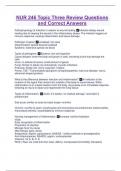NUR 246 Topic Three Review Questions
and Correct Answers
Pathophysiology of infection in relation to wound healing ✅Infection delays wound
healing due to keeping the wound in the inflammatory phase. The infection triggers an
immune response, causing inflammation and tissue damage.
Pathogen invasion ✅Localised: one area
Disseminated: spread beyond localised
Systemic: extensive spread via blood
Types of pathogens: ✅Bacteria: one cell organism
Cause disease: enter the body and grows in cells, secreting toxins that damage the
cells
Virus: no cellular structure, small amount of genes
Fungi: Similar to plants (no chlorophyll), mycotic infections
Protozoa: Single cell, micro-organism, malaria
Prions: TSE - Transmissible spongiform encephalopathies, mad cow disease, neuro,
abnormal shaped proteins.
What is the difference between infection and inflammation? ✅An infection is the
invasion of the agent that comes from outside of the body to injure tissues. While
inflammation is an inward reaction from the body, its purpose is an immediate response
following an injury to repair and regenerate the living tissue.
Types of inflammation: ✅Acute: 2-3 weeks, no residual damage, neutrophil is
predominant
Sub-acute: similar to acute but lasts longer <months.
Chronic: months to years, lymphocytes and monocytes are predominant (osteomyelitis,
rheumatoid arthritis), exacerbated by immune response.
Nursing management of inflammation: ✅Increase nutrition/hydration
Vitals
Early recognition of inflammation
Prevention of infection
Manage fever by cause
Med therapy (pain, temp)
Antipyretics: Aspirin, paracetamol, NSAIDS - inhibit synthesis of prostaglandins
Anti-inflammatories: NSAIDS, aspirin, corticosteroids
Vitamins: Vit A, B, C, D
RICE ( Rest, Ice (cold first then heat >48hrs), Compression/immobility, Elevation)
, Cellulitis: ✅Cause: spread of infection of dermis and SC tissue, A. Strep and S,
Aureus, leg ulcers, lymphoedema or venous disease
Location: generally, 1 lower leg
Common: elderly
Symptoms: Red, hot, swollen, painful, fever, malaise, vomiting, dermacation between
affected and normal skin
Treatment: flucloxacillin
Pathophysiology of fever in infection: ✅- Monocytes-macrophages secrete cytokines
(IL-1, IL - 6, TNF)
- Cytokines reach hypothalamic temp-regulating centre
- They promote the synthesis and secretion of Prostaglandin E2
- PG E2 increases thermostatic set-point
- The automatic nervous system is stimulated
- Causing shivering, muscle contraction and peripheral vasoconstriction.
When and how to take a wound swab: ✅Take swab before patient has started
antimicrobial treatment
Levine Technique (best practice over Z technique)
- Hand hygiene and wear gloves
- Irrigate wound with normal saline
- Moisten swab with saline
- Identify clean viable tissue area (1cm square) and rotate swab on it
- Insert swab into sterile container
What is the role of IVABs in the treatment of infection? ✅- used to treat serious
infections, as it works faster than oral Abs
- Antibiotics treat infections cause by bacteria, they do not help with viral infection.
- they interfere with the bacterial cell wall causing lysis and death
Discuss the use of PICC lines for IVAB administration in the community ✅PICC =
Peripherally Inserted Central Catheter
Can stay in for 1 week to 6 months
Baxter infuser is the most common device used to administer IVABs in the community
Can shower will PICC as long as there is additional water proof protection over the port
(cling wrap).
Pathophysiology of PICC lines: ✅Placed under ultrasound guidance with local
anaesthetic
X-ray can be taken to ensure correct placement
Long catheter, inserted in the antecubital fossa
Basilic vein is preferred insertion site




